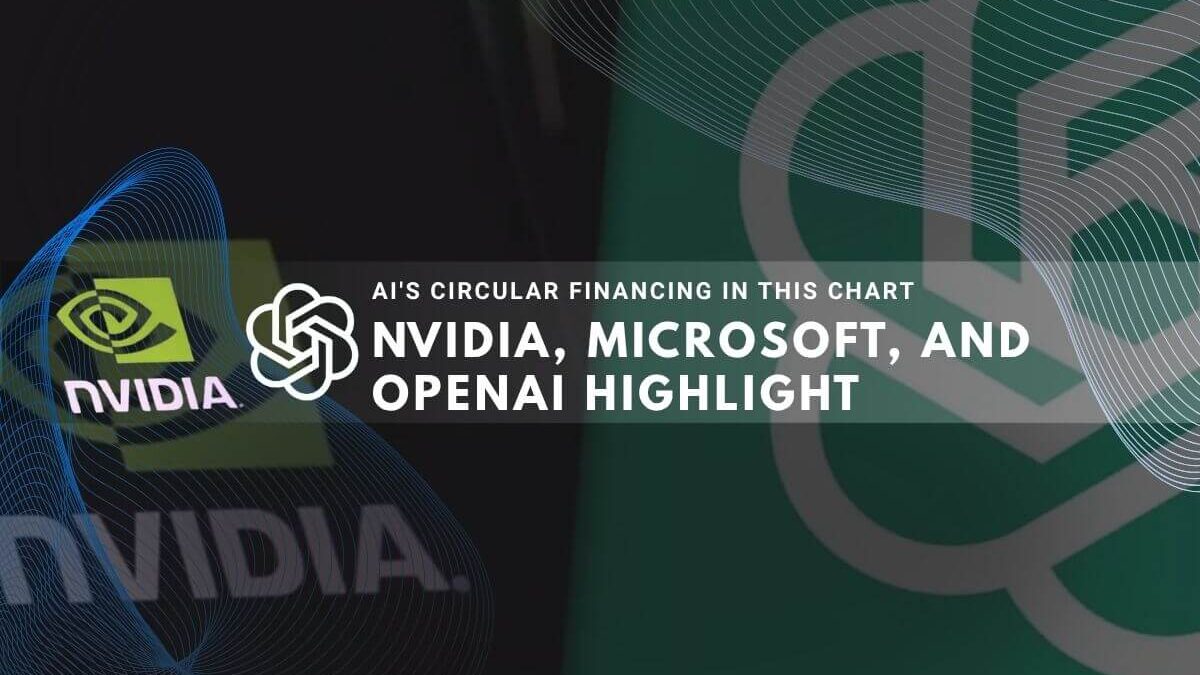Major technology firms Nvidia, Microsoft, and OpenAI represent a circular financing model in the artificial intelligence sector, where investments cycle back through interconnected business deals. Nvidia agreed in September 2025 to invest up to $100 billion in OpenAI, with much of that capital returning through GPU purchases [1][2][3]. This financial ecosystem now includes AMD and Oracle partnerships worth hundreds of billions, raising concerns among economists and industry leaders about market sustainability and potential bubble risks [4][5][6].
Nvidia’s $100 Billion OpenAI Investment Creates Feedback Loop
Nvidia announced a commitment to invest up to $100 billion in OpenAI during September 2025 [1][2]. The investment is structured as ten tranches of $10 billion each, tied to infrastructure deployment milestones [1]. OpenAI CFO Sarah Friar confirmed that most of the investment will return to Nvidia through GPU lease arrangements rather than upfront purchases [1].
The first $10 billion tranche was valued at a $500 billion OpenAI valuation, with subsequent tranches priced at prevailing market valuations [1]. This arrangement ensures Nvidia maintains its position as the primary infrastructure provider while gaining financial exposure to OpenAI’s software business [3]. CEO Jensen Huang stated OpenAI could become the world’s next multitrillion-dollar company [3].
Nvidia’s vendor financing strategy now totals $110 billion in direct investments plus another $15 billion in GPU-backed debt [1]. Beyond OpenAI, Nvidia holds a $3 billion stake in CoreWeave, which has spent $7.5 billion on Nvidia GPUs [1]. The company also maintains $3.7 billion in AI startup investments through NVentures [1].
AMD and Oracle Join Circular Financing Network
OpenAI announced an agreement with AMD worth tens of billions of dollars in chip purchases, making OpenAI one of AMD’s largest shareholders [6][7]. This deal followed days after the Nvidia announcement and represents a strategic diversification of OpenAI’s hardware suppliers [7].
Oracle secured a $300 billion partnership with OpenAI in September 2025 to construct AI data centers equipped with Nvidia chips [6][7]. These facilities will support OpenAI’s expanding infrastructure needs while generating revenue for Oracle’s cloud services division [8].
Microsoft maintains its position as a major OpenAI investor through earlier commitments that provided privileged access to OpenAI’s large language models [3]. This early investment enabled Microsoft to integrate ChatGPT into Azure cloud services and other software products, driving substantial growth in its cloud computing division [3].
Industry Experts Warn of Potential AI Bubble
Kristalina Georgieva, managing director of the International Monetary Fund, stated in October 2025 that global equity prices are approaching levels reminiscent of the internet boom 25 years ago [4]. She warned that a sharp correction could result in tighter financial conditions that suppress global growth [4].
Jamie Dimon, CEO of JPMorgan Chase, told the BBC that while AI is real and will yield returns, substantial money flowing into the sector may ultimately be squandered [4]. He compared the situation to how cars and televisions generated returns but many investors did not fare well [4].
Early AI pioneer Jerry Kaplan expressed particular alarm given the vast amounts of capital involved compared to the dot-com era [5]. Speaking at the Computer History Museum, Kaplan warned that when the bubble bursts, it will be catastrophic not only for those in AI but for the broader economy [5].
Market Data Reveals Concentration Risk
AI companies have contributed to 80 percent of the gains in the US stock market this year [5]. Gartner projects global AI spending could reach $1.5 trillion before the end of 2025 [5].
Nvidia CEO Jensen Huang estimated that between $3 trillion and $4 trillion will be spent on AI infrastructure in coming years [8]. This massive capital deployment underscores the scale of circular financing relationships connecting major technology firms [2][9].
Comparison to Historical Technology Bubbles
Nvidia’s direct investments total 85 percent of annual revenue, compared to Lucent Technologies’ vendor financing commitments of 20 percent during 1999-2000 [1]. Nvidia’s exposure is four times larger relative to revenue than Lucent’s official outstanding loans [1].
The GPU-backed debt market adds another layer of complexity. CoreWeave alone carries $10.45 billion in debt using GPUs as collateral [1]. An additional $10 billion in GPU-backed debt has emerged for cloud providers including Lambda Labs, which secured a $500 million GPU-backed loan [1].
Professor Anat Admati at Stanford Graduate School of Business noted that timing a bubble is incredibly difficult and you cannot definitively claim you were in one until after it has collapsed [5]. This uncertainty complicates risk assessment for investors and policymakers monitoring the sector [9].
Strategic Advantages Drive Investment Decisions
Nvidia’s CUDA software platform, launched in 2006, locked in most AI developers since foundational code was written for it [3]. The NVLink interconnect allows Nvidia GPUs to operate as one giant unit, providing technical advantages competitors struggle to match [3].
Collaboration between Nvidia and OpenAI occurs at chip, software, and systems levels [3]. This partnership gives Nvidia insight into computing needs of the most advanced AI models, allowing the company to shape future chips to match those workloads [3].
OpenAI’s Stargate initiative in Abilene, Texas, supported by Oracle and Japanese conglomerate SoftBank, continues expanding infrastructure capacity [5]. Nvidia maintains a stake in AI startup CoreWeave, which provides essential infrastructure for OpenAI operations [5].
The interconnected financial relationships among Nvidia, Microsoft, OpenAI, AMD, and Oracle create a self-reinforcing ecosystem where capital flows between companies buying each other’s products and services. Whether this model proves sustainable or collapses under its own weight remains the trillion-dollar question facing the technology sector [6][9].
